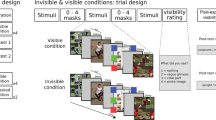Abstract
Visual words that are masked and presented so briefly that they cannot be seen may nevertheless facilitate the subsequent processing of related words, a phenomenon called masked priming1,2. It has been debated whether masked primes can activate cognitive processes without gaining access to consciousness3,4,5. Here we use a combination of behavioural and brain-imaging techniques to estimate the depth of processing of masked numerical primes. Our results indicate that masked stimuli have a measurable influence on electrical and haemodynamic measures of brain activity. When subjects engage in an overt semantic comparison task with a clearly visible target numeral, measures of covert motor activity indicate that they also unconsciously apply the task instructions to an unseen masked numeral. A stream of perceptual, semantic and motor processes can therefore occur without awareness.





Similar content being viewed by others
References
Marcel, A. J. Conscious and unconscious perception: experiments on visual masking and word recognition. Cogn. Psychol. 15, 197–237 (1983).
Forster, K. I. & Davis, C. Repetition priming and frequency attenuation in lexical access. J. Exp. Psychol. Learn. Mem. Cogn. 10, 680–698 (1984).
Holender, D. Semantic activation without conscious identification in dichotic listening, parafoveal vision and visual masking: a survey and appraisal. Behav. Brain Sci. 9, 1–23 (1986).
Cheesman, J. & Merikle, P. M. Priming with and without awareness. Percept. Psychophys. 36, 387–395 (1984).
Merikle, P. M. Perception without awareness: critical issues. Am. Psychol. 47, 792–796 (1992).
Dehaene, S. & Akhavein, R. Attention, automaticity and levels of representation in number processing. J. Exp. Psychol. Learn. Mem. Cogn. 21, 314–326 (1995).
McCarthy, G. & Donchin, E. Ametric for thought: a comparison of P300 latency and reaction time. Science 211, 77–80 (1981).
Coles, M. G. H., Gratton, G. & Donchin, E. Detecting early communication: using measures of movement-related potentials to illuminate human processing. Biol. Psychol. 26, 69–89 (1988).
Miller, J. O. & Hackley, S. A. Electrophysiological evidence for temporal overlap among contingent mental processes. J. Exp. Psychol. Gen. 121, 195–209 (1992).
van Turennout, M., Hagoort, P. & Brown, C. M. Brain activity during speaking: from syntax to phonology in 40 milliseconds. Science 280, 572–574 (1998).
Whalen, P. J. et al . Masked presentations of emotional facial expressions modulate amygdala activity without explicit knowledge. J. Neurosci. 18, 411–418 (1998).
Morris, J. S., Öhman, A. & Dolan, R. J. Conscious and unconscious emotional learning in the human amygdala. Nature 393, 467–470 (1998).
Berns, G. S., Cohen, J. D. & Mintun, M. A. Brain regions responsive to novelty in the absence of awareness. Science 276, 1272–1275 (1997).
Sahraie, A. et al . Pattern of neuronal activity associated with conscious and unconscious processing of visual signals. Proc. Natl Acad. Sci. USA 94, 9406–9411 (1997).
Tucker, D. Spatial sampling of head electrical fields: the geodesic electrode net. Electroencephalogr. Clin. Neurophysiol. 87, 154–163 (1993).
Perrin, F., Pernier, J., Bertrand, D. & Echallier, J. F. Spherical splines for scalp potential and current density mapping. Electroencephalogr. Clin. Neurophysiol. 72, 184–187 (1989).
Buckner, R. L. et al . Detection of cortical activation during averaged single trials of a cognitive task using functional magnetic resonance imaging. Proc. Natl Acad. Sci. USA 93, 14878–14883 (1996).
Author information
Authors and Affiliations
Corresponding author
Rights and permissions
About this article
Cite this article
Dehaene, S., Naccache, L., Le Clec'H, G. et al. Imaging unconscious semantic priming. Nature 395, 597–600 (1998). https://doi.org/10.1038/26967
Received:
Accepted:
Issue Date:
DOI: https://doi.org/10.1038/26967
- Springer Nature Limited
This article is cited by
-
An EPR study of the cognitive processes underlying the impact of self-relevant information on emotional word processing
BMC Psychology (2024)
-
Evidence for non-selective response inhibition in uncertain contexts revealed by combined meta-analysis and Bayesian analysis of fMRI data
Scientific Reports (2022)
-
Visual–auditory interactions on explicit and implicit information processing
Cognitive Processing (2022)
-
Analyzing the etiological functions of consciousness
Phenomenology and the Cognitive Sciences (2021)
-
Implicit Attitudes Towards Robots Predict Explicit Attitudes, Semantic Distance Between Robots and Humans, Anthropomorphism, and Prosocial Behavior: From Attitudes to Human–Robot Interaction
International Journal of Social Robotics (2021)





